1930's - The Tantalising Thirties | The Talkies 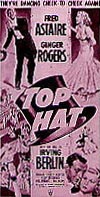 'Garbo speaks', on the posters for ANNA CHRISTIE in 1930, heralded the start of a golden era for a cinema industry that had found its voice in 1927 with the release of THE JAZZ SINGER. 'Garbo speaks', on the posters for ANNA CHRISTIE in 1930, heralded the start of a golden era for a cinema industry that had found its voice in 1927 with the release of THE JAZZ SINGER.
With Garbo's 'Gimme a viskey', the triumph of the spoken word over the silent film was almost complete, only Charlie Chaplin's little tramp refused to articulate his melancholy humour - though Chaplin did make a number of talking pictures without the tramp.
Surprisingly, talkies took some time to catch on. Problems with sound reproduction led many film directors to label the new process a passing fad.
But by the early 30's, it was being taken seriously, as unfortunate stars such as Pola Negri and John Gilbert had cause to regret -- Negri's impenetrable accent destroyed her career, while Gilbert's voice proved to be 'pear-shaped'. Others, though, such as Ronald Colman, Joan Crawford and the redoubtable Garbo, survived the transition and became bigger stars than ever. In fact, the talkies led to the birth of the Hollywood personality cult. Girls began to model their hairstyles and make-up, which had only become acceptable in the 20's, on screen idols. Men were equally affected: Clark Gable caused the collapse of a whole section of the haberdashery industry in 1936, when a scene in IT HAPPENED ONE NIGHT showed that he did not wear a vest. Sound also meant that the subject matter and style of films could range ever wider. In addition to the romances, historical epics and melodramas of the silent era, there were now other possibilities: the comedies of Howard Hawks, like BRINGING UP BABY the socially-conscious lines of MR DEEDS GOES TO TOWN, the musical extravaganzas of Nelson Eddy and Jeanette Macdonald, of Fred Astaire and Ginger Rogers, the farces of the Marx Brothers, and the full-length colour fantasy of Disney's SNOW WHITE. But one more technological breakthrough was still to come. In the late 30's, colour transformed the second-rate into something eminently watchable. It provided the potential for films to become not just works of cinema but of art -- as exemplified by the legendary GONE WITH THE WIND of 1939. |
| Palais-de-danse As new songs were popularised by the wireless and the gramophone, and social rigidities were relaxed, dance-halls sprang up throughout Britain. Here the young could practise the latest dance steps, show off their fashionable clothes and flirt. Soon a night at the local palais was a favourite way of spending an evening out. It was the age of the dance band, and band leaders such as Harry Roy, Joe Loss and Henry Hall became stars in their own right. By the early 30's, the frenetic Charleston had given way to more romantic close dances, the modern waltz, the quickstep and the fox-trot. But in mid-decade, the beat livened, as American Swing swept the halls, together with the Latin rumba. Glen Miller was at the forefront, and IN THE MOOD, recorded in August 1939, became a palais standard, crowding the dance floors every night. |
| Tommy Farr 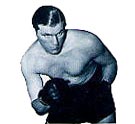 The name of Tommy Farr rarely figures in the list of boxing greats of the 30's: Joe Louis, Primo Carnera, Gene Tunney and Max Schmelling. The name of Tommy Farr rarely figures in the list of boxing greats of the 30's: Joe Louis, Primo Carnera, Gene Tunney and Max Schmelling.
But in August 1937, the Welshman became a national hero when he took Joe Louis, 'the Brown Bomber', 15 rounds in an epic fight, heard by millions on the wireless, and became one of only three who went the distance in 25 defences. Even now, some rate him the century's best UK heavyweight. |
| Flying Boats 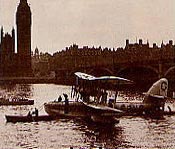 In 1934, when VOGUE observed that "everyone is learning to fly", and the flight from London to Paris took a mere three hours, aviation was beginning to lose its excitement and novelty. In 1934, when VOGUE observed that "everyone is learning to fly", and the flight from London to Paris took a mere three hours, aviation was beginning to lose its excitement and novelty.
But flying boats still had an aura of adventure, elegance and mystique. Since it was equally at home on solid ground and water, a flying boat was ideal for the intrepid explorer -- ideal for fashionable couples off to shoot big game in Africa, for example. But a trip on an Imperial Airways' Empire Flying Boat, nicknamed Queen of the Skies, could be an exercise in good living too. Five star service and superb cuisine were its hallmarks. Up to 24 passengers could doze in bunks after a gourmet lunch, or stroll on an enclosed promenade deck, while cruising for 800 miles at 165 mph. Until World War 11 changed the face of aviation, a trip on a flying boat was the height of fashion. |
| The Lambeth Walk In recent years, the strains of the LAMBETH WALK have been heard again in London's West End, as yet another theatrical revival proves that old musicals have a potency seldom matched by the new. As in the late 30's, Pearly Kings and Queens strut and two-step through the chorus, before yelling 'Oi!' on the final beat. The song came before the dance, as one of the numbers in the hit show of 1937, ME AND MY GIRL -- 'wonderfully vulgar' as VOGUE judged it. The star, Lupino Lane, belted out Noel Gay's song to a swaggering walk, and the tune, but not the walk, caught the imagination of Adele England, a dance teacher. The public were so taken with the dance she invented that over 350,000 music sheets of the LAMBETH WALK were sold in just six months. In no time both song and dance had swept Britain, then France and America. Thousands who had no idea where or what Lambeth was ensured its immortality in the annals of popular music. |
| Stop me and Buy One 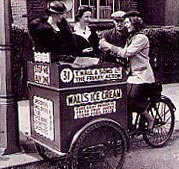 American ice cream -- first served in 1904 as 'frozen cream' -- took some time to reach Britain. Once introduced, though, it soon became a national passion, as Wall's the sausage-makers, saw. American ice cream -- first served in 1904 as 'frozen cream' -- took some time to reach Britain. Once introduced, though, it soon became a national passion, as Wall's the sausage-makers, saw.
By 1939, some 7,500 Wall's salesmen were riding Britain's roads on tricycles with fitted refrigerators, carrying the slogan 'Stop Me and Buy One'. Children who obeyed watched wide-eyed as 2d briquettes, choc-bars and tubs emerged from the chilly white depths. Soon after conscription started in April 1939, women began to take the place of the salesmen on these Wall's tricycles, pedalling the streets in navy blue, knee-length didided skirts and blue and white jackets. |
| Comics 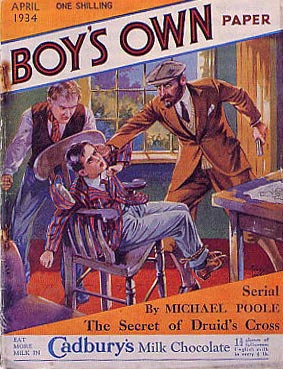 Few had a television set in the 30's, and the young had to look elsewhere for distraction. On Saturdays, they found it with Hopalong Cassidy at their local cinema club, but during the week, children turned to the make-believe world of story papers and comics. Few had a television set in the 30's, and the young had to look elsewhere for distraction. On Saturdays, they found it with Hopalong Cassidy at their local cinema club, but during the week, children turned to the make-believe world of story papers and comics.
Smaller children were enthralled by CHICK'S OWN, PLAYBOX, RAINBOW and PUCK, but older children cheered the GEM and MAGNET, the earliest and best of their genre. Also there were DETECTIVE WEEKLY, starring the popular sleuth Sexton Blake, CHAMPION, THRILLER and TRIUMPH. GEM and MAGNET were produced almost entirely by Charles Hamilton who wrote 5,000 stories under 26 pseudonyms. His best-known creation, as 'Frank Richards', was Billy Bunter, "the fat owl of the Remove". Competition came later from D C Thomson's 'Big Five' - ADVENTURE, ROVER, WIZARD, SKIPPER and HOTSPUR - which soon dated GEM and MAGNET. Then Thomson launched DANDY (1937) and THE BEANO (1938), and Desperate Dan, Lord Snooty and Korky the Cat became friends to generations of children. They are collectors' items today but in the 30's the tales of adventure and skulduggery in comics and story books, such as the BOY'S OWN PAPER, thrilled a generation of children that largely lacked television and had to rely on the written word. |
| Woolworths - The 3d & 6d Store 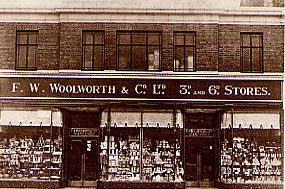 Despite the soup kitchens and dole queues of the 30's, most people in Britain were starting to enjoy a boom in their standard of living. Despite the soup kitchens and dole queues of the 30's, most people in Britain were starting to enjoy a boom in their standard of living. Many of their small luxuries and larger necessities were supplied by outlets of the great American chain store F W Woolworth, whose slogan greatly appealed to a population that, nevertheless, had to watch the pennies. When cash was particularly short, a customer could buy in stages. So a saucepan was sold in parts: 6d for the pan, and 6d for the lid; spectacle frames cost 6d, and the lenses another 6d each. Woolworths sold a wide variety of goods -- in fact, almost everything under the sun, bar the fanciest items: electrical and mechanical goods, clothes, food and sweets, records and the newly available Penguins, conveniently priced at 6d. The first Woolworths opened in London in 1909, but it was not until the company's public flotation in 1931 that it really took off. There were cries about 'Americanisation', but soon Woolworths was a high-street fixture, as British as roast beef. In the early 1930's the claim was that a new Woolworth branch was opened every 18 days. |
| Nippies, Lyons and ABCs 'Nippies' -- those pert waitresses with their starched aprons, caps and a ready smile -- epitomised the swift, cheerful service expected by customers of Lyon's Teashops -- and 'Corner Houses', as their larger establishments were commonly known. From the 30's to the 50's, they were a national institution, serving tea and cakes at notably reasonable prices to the country's workers. Lyon's main rivals in mass catering were the ABC chain. An ABC menu from 1932 highlights the superb value on offer: thick mock turtle soup, roast ribs of beef and Yorkshire pudding, boiled potatoes, spring greens, bread-and-butter pudding or a roll and cheese all for the princely sum of 1s 6d. |
| The First Penguins 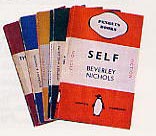 Library paperbacks were the brainchild of one man, publisher Allen Lane. He believed that far more people wanted to read books than the affluent middle classes, who alone could afford hardbacks. Library paperbacks were the brainchild of one man, publisher Allen Lane. He believed that far more people wanted to read books than the affluent middle classes, who alone could afford hardbacks. Lane's colleagues were not convinced, and so the birth of Penguin, his imprint, was humble indeed. On just £100, offices were set up in the crypt of a London church, where the empty tombs did service as filing cabinets and the crypt was used to store petty cash receipts. The first title appeared in the distinctive orange-and-white covers in July 1935: ARIEL by the popular French author Andre Marois, selling for 6d. It was an instant success. Soon other colours were used, each indicating a different type of book: green meant murder and mystery, for example, and blue marked non-fiction. In a startlingly short time, Lane's dream had revolutionised both an industry, and public reading habits. Allen Lane's vision meant that, for the first time, the public could buy good, well-produced books at affordable prices. |
|


